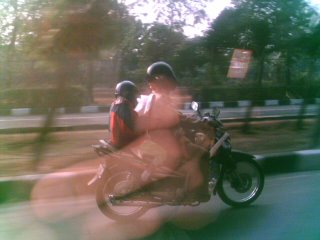The last couple of days I have been tutoring my brother on the art of driving. Since I failed to find any decent tips of driving in the internet, I was forced to make the tips up and create guideline along the way. Now I want to share those. In this post, I'll talk about guideline first.
Without further ado, here it is:
There are 3 components of driving environment: static, dynamic, and context dependent components. Static components is road. Dynamic components are everything that can change such as cars and pedestrians. Context dependent components are everything that depends on the situation..
If you are not familiar with the static component of an area, be cautious. You may assume that the static components always follow certain guidelines, such as a dead end will be marked however rudiment the mark is. But remember that some guidelines may not be reliable, for example a lack of continuous line in a wide road of a road pairs, do not imply a one way road. So again, be cautious.
At night, extra caution is necessary. What seems to be a smooth well-paved road may be damaged somewhere in the middle. Follow the tail of another car if available. If the driver in front is familiar with that road, all is well. If she doesn't , let her eat that damaged road or road bump so you can avoid them.
It goes without saying that you shouldn't pass another car on unfamiliar road at night. An unexpected road bump while passing another car might fly you and your car to heaven.
Back to theory, the dynamic component is the result of human interactions such as drivers and pedestrian. To account for dynamic component, you must consider not only human uncertainty, but also physical limitation.
In considering human uncertainty, be prepared that a pedestrian might suddenly step back in the middle of a road while crossing (I was in a taxi who hit such road crosser..). Also be prepared that a driver might decide to suddenly take a left turn, or right turn, or even suddenly stop. These things happen.
Luckily such erratic behaviors may be made sense by.. the static component! For a driver to suddenly turn left, most likely there is a road going left. For a driver to suddenly stop, most likely there is a change of road up there or there is an intersection. So, if you know in advance what the road will be up there, anticipate other drivers behavior by, for example, always slow down at intersection.
However unexpected a driver is, a car cannot suddenly stop immediately to halt or suddenly reach a certain speed or suddenly turns, because of physical limitation. Physical limitation are engine power per weight and momentum per breaks, which in turn define how fast can a car accelerate and deaccelerate. For example, due to engine power per weight, you know you have the time to safely move to the front of a huge truck since it can't possibly accelerate fast enough to hit you. On the other hand, because of momentum per breaks, you know you can't take a lane because that particular car cannot possibly stop in time.
If ability to measure such effect is sharpen, you will be able to see more opening while driving and accurately assess potential danger.
The third component, which is context dependent component, depends on the area. This component is very interesting because it's a complex adaptive system where the agents have collectivist culture (who are more sensitive to high context communication), but miraculously manage to avoid fatal traffic jam (local minima) and exchange role flawlessly while being a member of an arbitrary group (formed around congestion centers). In other words, the driving environment in Indonesia is analogous a collectivist society which limit is pushed to the extreme without breaking.
I might blog about it in the future.
Anyway, in practice, context dependent component basically requires you to observe and learn interaction between cars and pedestrians. Try to experience different situations so you finally know for certain: when you can finally do the difficult U turn with all that cars moving so fast and somehow that speeding car know that he is the one who should stop, or when you deserved that new lane without pissing people of in a traffic jam. Once you know such moments, congratulations! You have been successfuly assimilated into the system.
Afterward, you can slowly push the limit to your advantage without disrupting the system..
